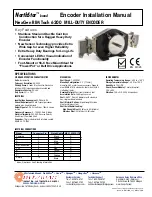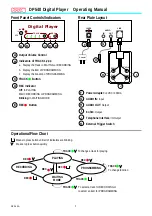
Page 6
MECHANICAL INSTALLATION
3.2 Pulley Mounting
1. Mounting the Model 6200 onto mounting bracket
with four 3/8-16 UNC bolts through foot mounting
bracket holes.
NOTE The mounting bracket should be
strong enough to sufficiently support the
weight of the RT 6200 (approximately 25
pounds) without excessive deflection of
play due to load or excessive vibration.
Deflection can cause erroneous outputs
and shorten operational life of the unit.
2. Mount and connect 5/8 inch I.D. pulley on to the
RT 6200 input shaft.
3. Install a tension belt according to the
manufacturer’s specifications. If the belt tension is
too light it can cause pulley slippage or backlash,
thereby creating an erroneous signal output.
However, for maximum operational life of the
Model 6200, a belt tension loading of less than 40
pounds should be used.
Pulley Mounting
4.0 Sensor Module Installation
To install the sensor Module, perform the following
steps. See Figure, below.
1. Remove sensor module and mating connector
from packaging. CAUTION! Although the device is
protected from Electrostatic Discharges up to 2000
Volts, standard ESD precautions should be followed.
2. Separate mating connector from sensor module
by releasing the two latches.
CAUTION! Use caution when handling the
sensor module. The sensor at the end of the
module can be easily damaged by sharp
objects. The sensor module can be damaged
by sudden shocks (dropping, hammer blows,
etc.).
3. Insert sensor module into opening in enclosure.
The sensor assembly is keyed to ensure proper
orientation.
4. Locate four shoulder screws. Insert shoulder
screws through clearance holes in sensor module
and into tapped holes in enclosure. Tighten to a
nominal 5 inch-pounds.
CAUTION! There should not be a gap
between the lip on the housing and the
enclosure. The stainless steel sensor module
is designed to seat in metal to metal contact
with the enclosure. Ensure that no gaskets,
paint, dirt, etc., interferes with the complete
seating of the module in the enclosure.
Sensor Module


























